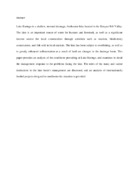| dc.contributor.author | Odada, Eric O. | |
| dc.contributor.author | Onyando, Japheth O. | |
| dc.contributor.author | Obudho, Peninah A. | |
| dc.date.accessioned | 2022-12-06T06:58:49Z | |
| dc.date.available | 2022-12-06T06:58:49Z | |
| dc.date.issued | 2006-12-08 | |
| dc.identifier.citation | Dolphine Teyo Ombasa, Job Rotich Kosgei, Gilbert Nyandwaro, Eva Subira Munishi, Multi-criteria approach to assess groundwater potential: a case study of Baringo County, Kenya, Water Practice and Technolog | en_US |
| dc.identifier.uri | https://doi.org/10.1111/j.1440-1770.2006.00309 | |
| dc.identifier.uri | https://karuspace.karu.ac.ke/handle/20.500.12092/2672 | |
| dc.description | Addressing threatened biodiversity and livelihoods | en_US |
| dc.description.abstract | Lake Baringo is a shallow, internal drainage, freshwater lake located in the Kenyan Rift Valley.
The lake is an important source of water for humans and livestock, as well as a significant
income source for local communities through activities such as tourism, biodiversity
conservation, and fish sold in local markets. The lake has been subject to overfishing, as well as
to greatly enhanced sedimentation as a result of land use changes in the drainage basin. This
paper provides an analysis of the conditions prevailing at Lake Baringo, and examines in detail
the management response to the problems facing the lake. The roles of the many and varied
institutions in the lake basin's management are discussed, and an analysis of internationally
funded projects designed to ameliorate the situation is provided | en_US |
| dc.language.iso | en | en_US |
| dc.subject | sedimentation | en_US |
| dc.subject | biodiversity | en_US |
| dc.subject | Lake baringo | en_US |
| dc.subject | land use change | en_US |
| dc.subject | lake basin management | en_US |
| dc.subject | Global Environment Facility | en_US |
| dc.subject | fishing moratorium | en_US |
| dc.title | Lake Baringo: Addressing threatened biodiversity and livelihoods | en_US |
| dc.type | Article | en_US |
